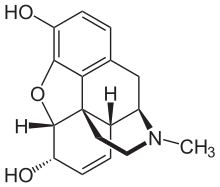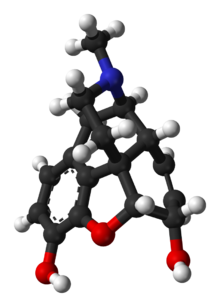**Medical Uses and Effects**:
– Morphine is used to treat acute and chronic severe pain, with analgesic effects lasting 3-7 hours.
– It is beneficial in managing pain from myocardial infarction, during labor, and for acute pulmonary edema treatment.
– Morphine reduces shortness of breath in cancer and noncancer conditions, with sustained-release formulations proving effective.
– It is used in opiate substitution therapy for opioid use disorder and as an alternative for addiction treatment when methadone or buprenorphine are not tolerated.
– Concerns exist about increased mortality in non ST elevation myocardial infarction cases.
– Morphine can cause constipation due to its effects on the intestinal tract and may lead to hormone imbalances like hypogonadism in chronic users.
**Addiction and Tolerance**:
– Morphine is highly addictive and ranks as one of the most addictive substances, similar to heroin.
– Tolerance develops at a similar rate for heroin and morphine, with equipotent doses having comparable effects.
– Former opiate addicts show no preference between heroin and morphine, indicating their similarity in addictive potential.
– The development of tolerance involves receptor phosphorylation, receptor down-regulation, and upregulation of the cAMP pathway.
– Withdrawal symptoms of morphine include insomnia, diarrhea, and severe abdominal pain, progressing through various stages.
**Pharmacology and Toxicity**:
– Morphine interacts with μ, δ, and κ-opioid receptors, primarily activating the μ-opioid receptor for analgesia and sedation.
– It has different affinities at opioid receptors and binds to μ-opioid receptors in the brain and spinal cord, leading to effects like analgesia, sedation, euphoria, and respiratory depression.
– Morphine has a molar mass of 285.338 g/mol, acidity levels of 8.21 and 9.85, solubility of 0.15 g/L at 20°C, and a melting point of 255°C.
– Its pharmacokinetics involve various administration routes and metabolism primarily in the liver, with metabolites like morphine-3-glucuronide and morphine-6-glucuronide.
– Extended-release formulations provide longer-lasting effects, and chiral forms influence its biological activity.
**Gene Expression and Immune System Effects**:
– Morphine can alter gene expression related to mitochondrial respiration and cytoskeleton proteins, impacting various cellular processes.
– Chronic morphine use may affect the immune system by influencing cytokine production, as opiate receptors are expressed on immune cells.
– Regulation of cytokines in the immune system can be affected by morphine via specific pathways, potentially impacting immune responses.
– Studies indicate morphine’s influence on gene regulation and immune system function, highlighting its broader effects beyond analgesia.
**Biosynthesis and Chemistry**:
– Morphine biosynthesis in humans involves enzymes like CYP2D6 and a pathway from L-tyrosine, with implications for conditions like Parkinson’s disease.
– In opium poppy, morphine is derived from reticuline through specific enzymatic processes, with efforts to replicate biosynthesis in yeast.
– Morphine’s structure has been used to create synthetic drugs like levorphanol and dextromethorphan, with modifications leading to non-narcotic derivatives.
– Morphine serves as a precursor for various opioids like heroin, hydromorphone, and oxymorphone, with semi-synthetic opioids derived from its carbon skeleton.
– Various derivatives and agonist-antagonist drugs have been developed based on modifications of the morphine molecule, with considerations for stereoselectivity in pharmacological actions.
Morphine, formerly also called morphia, is a strong opiate that is found naturally in opium, a dark brown resin produced by drying the latex of opium poppies (Papaver somniferum). It is mainly used as an analgesic (pain medication). There are numerous methods used to administer morphine: oral; sublingual; via inhalation; injection into a muscle, injection under the skin, or injection into the spinal cord area; transdermal; or via rectal suppository. It acts directly on the central nervous system (CNS) to induce analgesia and alter perception and emotional response to pain. Physical and psychological dependence and tolerance may develop with repeated administration. It can be taken for both acute pain and chronic pain and is frequently used for pain from myocardial infarction, kidney stones, and during labor. Its maximum effect is reached after about 20 minutes when administered intravenously and 60 minutes when administered by mouth, while the duration of its effect is 3–7 hours. Long-acting formulations of morphine are available as MS-Contin, Kadian, and other brand names as well as generically.
 | |
 | |
| Clinical data | |
|---|---|
| Pronunciation | /ˈmɔːrfiːn/ |
| Trade names | Statex, MS Contin, Oramorph, others |
| AHFS/Drugs.com | Monograph |
| MedlinePlus | a682133 |
| License data | |
| Pregnancy category |
|
| Dependence liability | High |
| Addiction liability | High |
| Routes of administration | Inhalation (smoking), insufflation (snorting), by mouth, rectal, subcutaneous, intramuscular, intravenous, epidural, intrathecal |
| Drug class | Opioid |
| ATC code | |
| Legal status | |
| Legal status |
|
| Pharmacokinetic data | |
| Bioavailability | 20–40% (by mouth), 36–71% (rectally), 100% (IV/IM) |
| Protein binding | 30–40% |
| Metabolism | Liver: UGT2B7 |
| Metabolites | • Morphine-3-glucuronide (90%) • Morphine-6-glucuronide (10%) |
| Onset of action | 5 minutes (IV), 15 minutes (IM), 20 minutes (PO) |
| Elimination half-life | 2–3 hours |
| Duration of action | 3–7 hours |
| Excretion | Kidney 90%, bile duct 10% |
| Identifiers | |
| |
| CAS Number |
|
| PubChem CID | |
| IUPHAR/BPS | |
| DrugBank | |
| ChemSpider | |
| UNII | |
| KEGG | |
| ChEBI | |
| ChEMBL | |
| PDB ligand | |
| CompTox Dashboard (EPA) | |
| ECHA InfoCard | 100.000.291 |
| Chemical and physical data | |
| Formula | C17H19NO3 |
| Molar mass | 285.343 g·mol−1 |
| 3D model (JSmol) | |
| Solubility in water | HCl & sulf.: 60 |
| |
| |
| (verify) | |
Potentially serious side effects of morphine include decreased respiratory effort, vomiting, nausea, and low blood pressure. Morphine is addictive and prone to abuse. If one's dose is reduced after long-term use, opioid withdrawal symptoms may occur. Common side effects of morphine include drowsiness, vomiting, and constipation. Caution is advised for use of morphine during pregnancy or breast feeding, as it may affect the health of the baby.
Morphine was first isolated between 1803 and 1805 by German pharmacist Friedrich Sertürner. This is believed to be the first isolation of a medicinal alkaloid from a plant. Merck began marketing it commercially in 1827. Morphine was more widely used after the invention of the hypodermic syringe in 1853–1855. Sertürner originally named the substance morphium, after the Greek god of dreams, Morpheus, as it has a tendency to cause sleep.
The primary source of morphine is isolation from poppy straw of the opium poppy. In 2013, approximately 523 tons of morphine were produced. Approximately 45 tons were used directly for pain, an increase of 400% over the last twenty years. Most use for this purpose was in the developed world. About 70 percent of morphine is used to make other opioids such as hydromorphone, oxymorphone, and heroin. It is a Schedule II drug in the United States, Class A in the United Kingdom, and Schedule I in Canada. It is on the World Health Organization's List of Essential Medicines. Morphine is sold under many brand names. In 2021, it was the 156th most commonly prescribed medication in the United States, with more than 3 million prescriptions. It is available as a generic medication.
